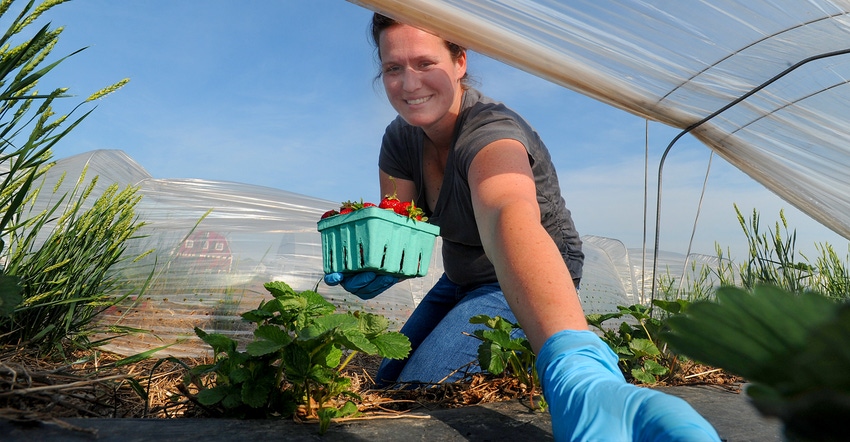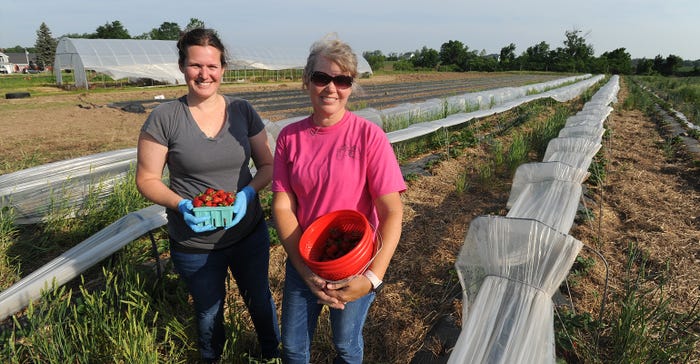June 23, 2017

Imagine extending your strawberry season from three weeks out to five months or more. Low-tunnel technology is doing that at Panek’s Pickin’ Patch at Albion, N.Y.
Berries are a key crop at this Community-Supported Agriculture farm that was started more than 30 years ago by Kerry Panek. Today, Kerry and daughter-in-law Guinevere “Guin” Panek grow 5 acres of strawberries, with a half-acre dedicated to day-neutral varieties.
Guin started growing day-neutral berries 10 years ago. The varieties produce continuously summer through fall. She tried high-tunnel production for three years, then “Cornell’s low-tunnel strawberries research caught my attention.”
The $5,000 investment in 2,500-foot-long low tunnels was a substantial expense for this small family farm. But it paid off. “The low tunnels work really well. We recovered our initial investment quickly with the longer harvest of high-quality fruit, and the reduced loss of fruit to water damage and disease pressure,” she says.
 PARTNERS: Guin (left) and mother-in-law Kerry Panek are more than pleased with their low-tunnel berry production.
PARTNERS: Guin (left) and mother-in-law Kerry Panek are more than pleased with their low-tunnel berry production.

In 2016, despite ice-coated tunnel tops, Panek’s Pickin’ Patch was still delighting CSA members with fresh berries into late October. The harvest window generally extends until a late-season hard frost.
The right tunnel and right berries
Time spent selecting the right low-tunnel system was well-spent. Based on Cornell University research, Guin chose a Canada-made Dubois Agrinovation system.
“Sides are easily lowered at the first hint of poor weather and can be put part way up for picking,” she explains. “We are seasoned weather-watchers. Compared to how much we gain in fruit quality, we don’t mind the work to ‘operate’ the tunnels.”
Clear, 1.5-mil plastic that reduces UV light cuts down on fungal spore germination and infrared light that can produce unwanted heat. The plastic also nearly eliminates Botyris gray mold and powdery mildew. Lack of rain splash also reduces insect and disease issues. In previous years, with rain, sometimes more fruit was thrown away than what was salable.
Guin aims to plant no later than the first week of May — earlier if weather permits. Low tunnels go on once plants throw new flower trusses.
The Albion day-neutral variety, with relatively high brix and flavorful berries, is the “queen” of this system. The plants, favoring tunnel-controlled temperature and humidity, are hand-set at a higher density than June-bearers and require more frequent harvesting.
“Day-neutral berries grown in low tunnels have become my niche,” says Guin with a big smile. “I can provide season extension for our farm stand, farmers markets and CSA.”
Introduction of flavorful, day-neutral strawberries created excitement in the 1980s. But it was sapped by low yields, small fruit and insect issues, reflects Marvin Pritts, Cornell Extension small fruit specialist. Now, combined with new day-neutral varieties like Albion, “new plastics with low tunnels is breathing new life into strawberry production,” adds Pritts, who received New York Farm Viability Institute funding for low-tunnel strawberry research.
Proof is in the paycheck
Pritts’ tunnel trials produced 27% higher yield and 15% more marketable fruit compared to uncovered first-year plants. When plants were held over into a second, very cold spring, yields were 239% higher with a 37% higher rate of marketable berries under cover compared to weather-exposed plantings.
Pritts notes some New York growers of Albion berries have reported gross sales of up to $80,000 per acre, with $40,000 more typical. Material costs per acre run an estimated $40,000 to $44,000 for that initial year.
First-year net profit is estimated at $18,000 per acre, accommodating for startup costs. Profits increase in subsequent years with less required investment plus reuse of the plastics for one year, sometimes two.
“Low-tunnel production could transform strawberry production in the Northeast,” contends Pritts. “It’s already used in many regions of the world where benefits are even less than what we experience here.”
Pritts’ new guide for growing low-tunnel strawberries is online at hort.cornell.edu/fruit/pdfs/low-tunnel-strawberries.pdf.
Dunn writes from Mannsville, N.Y.
Grow a 9-month berry season
A Maryland low-tunnel study, reported in the International Journal of Fruit Science, supported a nine-month strawberry season with harvest into December. The season extension was facilitated by the use of impact sprinklers to protect plants from extreme cold.
Check it out at bit.ly/2rvWSyy.
14 tips for growing low-tunnel strawberries
Consider these experience-based tips from Cornell’s Marvin Pritts:
• Establish raised beds in late fall or early spring to allow for early-spring planting.
• Use trickle irrigation with a fertilizer injection system.
• Cover each bed with white plastic.
• Plant Albion in a staggered double row with plants 9 to 12 inches apart.
• Insert plant roots into bed, disturbing the plastic as little as possible.
• Weekly fertilize with nitrogen after planting, increasing rate once plants begin to set fruit.
• Remove flowers for first three weeks or until vigorous new leaves appear from crown.
• Use straw mulch, landscape fabric or grass seeding between rows to prevent mud splash on berries.
• Install tunnels when plants begin to throw new flower trusses.
• Cover tunnels with 2- to 4-mil plastic, preferably a type that excludes UV light and reduces infrared radiation; keep one side up to allow pollination and prevent heat buildup.
• Lower sides when weather is cold or stormy.
• Harvest fruit at least twice weekly.
• Extend harvest season once temperature falls below 40 degrees F by lowering towels; below 30 degrees, cover entire field with row cover at night.
• Once harvest is over, lower or remove plastic and cover beds with straw.
NYFVI is a farmer-led nonprofit that invests in innovative projects to increase the success of ag production enterprises, protect farm-based natural resources and produce measurable farm-level results. Visit nyfvi.org for more information.
About the Author(s)
You May Also Like




